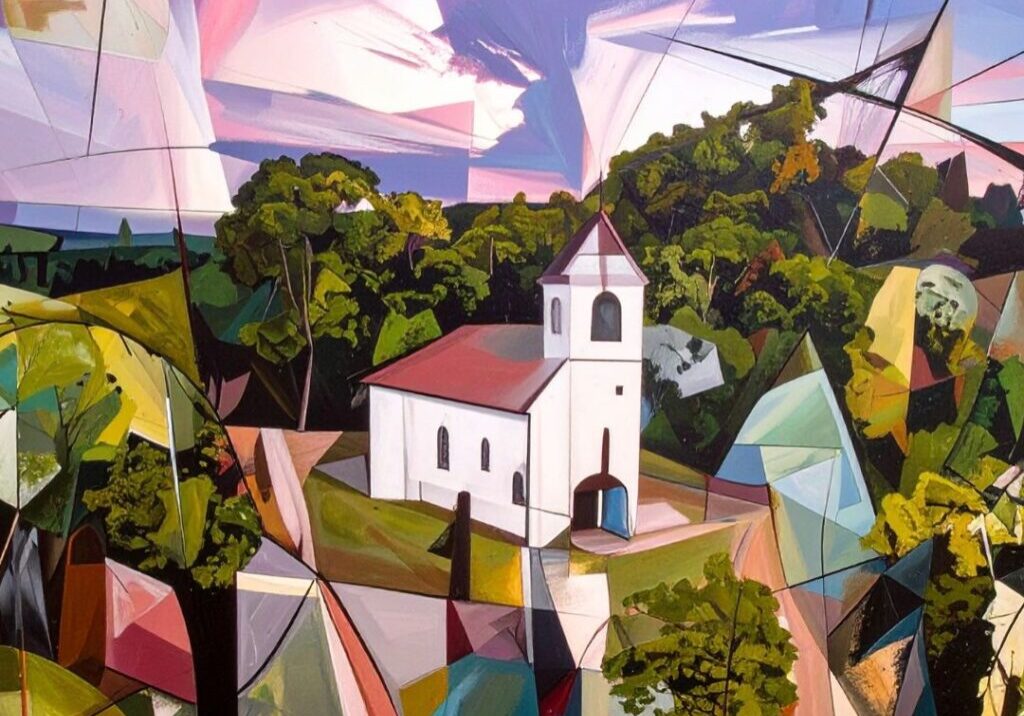Crum Creek Visitation
I recently encountered a great blue heron while teaching my Swarthmore College class, Religion and Ecology. I was conducting a three-hour class meeting in the Crum Woods, the scenic watershed adjacent to the Swarthmore campus and near my home where I live with my family. The class began with a silent procession into the woods where I asked each student to experience being “summoned” by a particular life-form in the forest – blue jay, gray squirrel, red oak, water strider, skunk cabbage, and so on – and then to re-imagine ourselves as “becoming” that life-form. After the walk through the woods we gathered in an open meadow, under the shade of a grove of sycamore trees, so that each student and I could “speak” in the first person from the perspective of the individual life-form we had assumed.
I explained that this was a voluntary exercise, and that no one should feel compelled to speak if he or she did not want to. I said, If you imagine yourself, for example, as a brook trout or morning dove or dragonfly living in and around the Crum Creek, with the creek threatened by suburban storm water runoff, invasive species, and other problems, what would you like to say to this circle of human beings? This group activity is a variation on a deep ecology, neo-Pagan ritual called “A Council of All Beings,” in which participants enact a mystical oneness with the flora and fauna in an area by speaking out in the first person on behalf of the being or place with which they have chosen to identify.[1] A Council of All Beings ritual enables members of the group to speak “as” and “for” other natural beings, inventively feeling what it might be like to be bacterium, bottle-nosed dolphin, alligator, old growth forest, or gray wolf. A Council is an exercise in imaginative ontology. Participants creatively metamorphose into this or that animal or plant or natural place and then share a message to the other human persons in the circle. The purpose of a Council, then, is to foster compassion for other life forms by ritually bridging the differences that separate human beings from the natural world.
Trained in religious studies, I was mentored to avoid leading contemplative practices in the classroom lest students confuse the academic study of religion with particular sectarian rituals. It is one thing to study, say, Christian monasticism as an intellectual exercise, so the argument runs, but quite another to practice the daily office as a spiritual exercise. But while I think it is wrong to try to inculcate particular religious beliefs or practices in the classroom environment, I have found my students increasingly hungry not only for religious studies as a mode of critical analysis, but also for the actual lived experiences that underlie and shape such studies. Thus I use contemplative rituals with students as integral to their academic inquiries. These exercises affectively ground the analytically discursive work of writing papers and taking exams in my classes. Now both modes of learning – heartfelt mindfulness and academic analysis – provide the sonic baseline that shapes the rhythms of my pedagogy. In this way, I conceive of my teaching as a type of soulcraft. My goal is not simply to communicate intellectual content, as important as that is, but, moreover, it is to facilitate conversation and contestation about transformative wisdom traditions grounded in affective practices and ritual formation.
So on this particular day, as I and my students were re-working our identities and speaking as new life-forms, a great blue heron broke the plane of blue sky above our heads and glided effortlessly toward the creek. We were spellbound. Flying with its neck bent back in a gentle horizontal “S” curve, its blue-black wings fully extended, and its long gray legs ram-rod straight and trailing behind, the heron darkened the sky above our heads and landed in the shallow water of the creek. It was as if a pterodactyl from one hundred and fifty million years ago had entered our gathering. The slow beat of its great wings – whomp, whomp, whomp – followed a stately rhythm from another era. Spontaneously, we jumped up from the meadow and walked heron-like – silent, hands held at our sides, strutting in the tall grass – toward this imperial creature who began to stalk and then strike its prey with its long yellow bill.
This is a visitation. My class and I now felt, it seemed to me, that our modified neo-Pagan shape-shifting practice had prepared us for a connection – a spiritual connection – to a regal bird whose presence electrified our gathering with agile dignity and rhythmic beauty. We had been discussing, and trying to ritually enact, our identities as fellow and sister members of this forest preserve in communion with the other life-forms found there. But to be graced with the overhead flight and practiced movements of the great blue heron transformed, at least for me, what we had been learning and practicing into a living relationship with a kind of forest deity, if I could be so bold. Together on the banks of the creek, we stood and watched the heron balance itself on one leg, silently step toward its quarry, jerk its bill toward an unsuspecting fish or frog, strike and swallow, and then rise in flight again off the creek, its great V-shaped wings flapping in slow-moving unison. I am not sure of my students’ experience at this point, but to me, I felt wonder and gratitude in the presence of this awe-inspiring creature, remembering Moses’ experience of God in the burning bush, “Come no closer! Remove the sandals from your feet, for the place on which you are standing is holy ground!” (Exodus 3:5).
In our outdoor class, we had been discussing how our lives were embedded in a sacred hoop greater than ourselves, that as human citizens of a wider biotic community we are surrounded by a cloud of witnesses who are calling us to our responsibilities for preserving the woods, preserving ourselves, preserving the world. Now I sensed my class and I knew what was at stake in this preservation. What was at stake was the preservation of this beautiful forest refuge – the Crum Woods, symbolized by the blue heron on the wing – as a biologically-rich home for it many denizens, including its human visitors who enjoy the forest from time to time for its many sensual and meditative delights. Whatever my students’ experience of the great blue heron was that day, for me, this encounter underscored my conviction that the Crum Woods is more than a biodiverse habitat; it is also, in my Christian vocabulary, a green sanctuary, a blessed community, a sacred grove, indeed, a holy place.
But, as we have seen, calling the Crum Woods, or any landscape, a sacred place is dangerously transgressive for the guardians of Christian orthodoxy who circumscribe the boundaries of Christian belief in the divine life to God alone. Such critics consider it idolatrous to open up the language of holiness or divinity to include the natural order of things. For example, Protestant ecotheologian John B. Cobb Jr., who emphasizes God’s presence in creation, appears wary of extending the horizon of the sacred to encompass the more-than-human world. He writes that Christian thinkers can “celebrate the growing sense of the sacredness of all creatures,”[2] but he then seems to back away from this claim, saying,
Nevertheless, that language is, from a historic Protestant perspective, dangerously misleading. Speaking rigorously, the line between the sacred and the profane is better drawn between God and creatures. To place any creatures on the sacred side of the line is to be in danger of idolatry . . . God is present in the world – in every creature. But no creature is divine. Every creature has intrinsic value, but to call it sacred is in danger of attributing to it absolute value. That is wrong.[3]
Another ecotheologian, Richard Bauckham, makes a similar point. While he extends the horizon of sacrality to the natural order of things, pace Cobb, he nevertheless contends that mainstream biblical teaching compels him to stop short of ascribing divinity to anything other than God. “The Bible has de-divinized nature,” he writes, “but it has not de-sacralized nature.”[4] Bauckham steps beyond Cobb’s polemic against sacred nature, but then he balks at the thought of attributing the attributes of God in Godself to the creaturely world as an expression of Pagan animism foreign to the tenets of what he calls the “Judeo-Christian tradition.” He continues,
The Judeo-Christian tradition certainly de-divinized nature. Nature is not reverenced as divine in a pantheistic or animistic sense. But deeply rooted in the Judeo-Christian tradition is the sense that all creatures exist for the glory of God and reflect the glory of God.[5]
Both Cobb and Bauckham rightly celebrate God’s presence in nature insofar as all things are reflections of God’s goodness and glory. They contend that nature should not be denigrated in utilitarian terms as an object of exploitation but valued instead as an expression of divine beauty and providence. Nevertheless, both authors’ anxieties about divinized nature and Pagan animism move them away from the model of Christian animism proposed here. Perhaps their caveat against ascribing sacred value (Cobb) or the quality of deity (Bauckham) to the creaturely world stems from their reading of Paul’s invective against Pagans who “exchanged the glory of the immortal God for images resembling mortal man or birds or animals or reptiles . . . they exchanged the truth of God for a lie and worshipped and served the creature rather than the creator” (Romans 1: 23, 25). But while this passage has traditionally been used to empty the world of signs of divine presence, it is important to note the historical context of Paul’s comments. Paul says it is wrong to worship God in the image of mortal humans and other beings, but what exactly does this mean in reference to Christianity’s core belief that God became flesh and should be worshipped as such accordingly?
In spite of Paul’s polemic against exchanging reverence for God for idol worship of a man, I do not think he is saying that Christians cannot glorify God in human and material form, because that is exactly what Christianity is – a religion that worships the manifestation of God in the flesh of a mortal man, Jesus of Nazareth, and, as I have maintained, also reveres the embodiment of God in the flesh of a mortal animal, the Holy Spirit. As well, this worship takes on many other earthly and creaturely expressions, in Paul’s time and in our own time – from devotion to icons and veneration of Mary to blessing the host and giving precious metals and candles to saints as votive offerings. In the light of Christianity’s foundational Trinitarian-incarnational identity, it is most plausible, then, that Paul is not inveighing against Christians who worship God in the form of mortal creatures or the material world. Rather, he is arguing against people outside the circle of biblical faith who divorce their religious devotion to images or other creaturely manifestations of God from the understanding of the enfleshment of God in Christian tradition. In Christian terms, and I think Paul would agree, it is not wrong to worship God in corporeal form, but it is wrong to do so and not celebrate such worship as giving praise to the God of the biblical witness who makes and sustains all things.
My point is that a thoroughgoing incarnational model of Christianity sees no division between the God of the biblical texts, on the one hand, and the sacred and divinized character of creation, on the other. Indeed, the two affirmations mutually support one another. In this regard, dialectically speaking, God and nature are one. Here I have sought to show that Christianity is a faith that celebrates the embodiment of God in many forms – and not only in human form in the person of Jesus, but also in animal form in the person of the Spirit. Christianity, as I have suggested, is a religion of double incarnation: in a twofold movement, God becomes flesh in both humankind and otherkind. Just as God became human in Jesus, thereby signaling that human beings are the enfleshment of God’s presence, so also by becoming avian in the Spirit, God signals that other-than-human beings are also the realization of God’s presence as well.
To suggest that Christian faith, at its core, centers on belief in God as a fully incarnated reality not only in the humanity of Jesus Christ, but also in the animality of the Holy Spirit, means that the embodied Spirit of God sets forth the whole wide-ranging world of non-human nature – the birds of the air, to be sure, but also the fish of the sea, the beasts of the field, the trees of the forest, indeed, all of creation – as saturated with divinity. And my practical point is that the full realization of this truth should lead all of us to comport ourselves toward the natural world in a loving and protective manner because this world is the unbounded fullness of God within the life of each and every created thing.
- “Crum Creek Visitation” is an excerpt from Mark Wallace’s latest book “When God Was a Bird: Christianity, Animism, and the Re-Enchantment of the World” (New York: Fordham University Press, 2019)
Notes:
[1] John Seed, et al. Thinking Like a Mountain: Towards a Council of All Beings (Gabriola Island, B.C.: New Society Publishers, 1988), and see Julia Butterfly Hill’s forest-based spiritual practice in her The Legacy of Luna: The Story of a Tree, a Woman, and the Struggle to Save the Redwoods (San Francisco: HarperSanFrancisco, 2000).
[2] John B. Cobb Jr., “Protestant Theology and Deep Ecology,” in Deep Ecology and World Religions: New Essays on Sacred Ground, ed. David Landis Barnhill and Roger S. Gottlieb (New York: SUNY Press, 2001) 223.
[3] Ibid.
[4] Richard Bauckham, Living With Other Creatures: Green Exegesis and Theology (Waco, Texas: Baylor University Press, 2011) 13.
[5] Ibid., 52.
 View print-friendly version
View print-friendly version
2 Comments
Related Posts

Mission for an Evolutionary Christianity
We are living through tumultuous times. Political polarization intensifies, violence against vulnerable populations escalates, and the foundational principles of human dignity face erosion. For many, the cognitive dissonance between professed…


Thank you Mark — your writing made for a series of beautiful meditative moments on an early mid-may morning — as I overlooked our Canadian prairie, awakening city of 1.3 million — while surrounded by 20 backyard garden boxes, stirring with the life of newly planted vegetable/flower seeds.
Beautiful